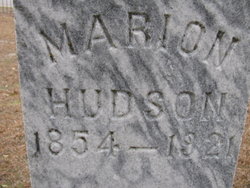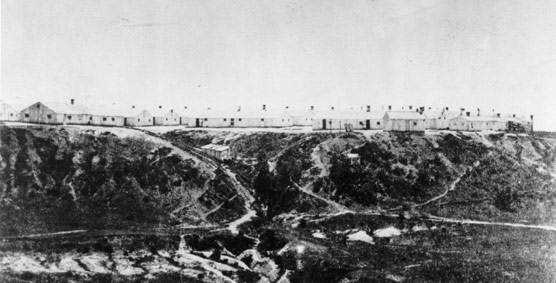Sweet Caroline
Burwell Hudson was the son of William Joshua Hudson 1796-1896 and his first wife, Elizabeth "Betsy" Smith. Joshua was known not only for his longevity, but for his prolificity.
Burwell was married twice, both times to Sarah's. His first wife was Sarah Ann "Sally" Lee, the daughter of James Calvin Lee and Elizabeth Duke.
Burwell and Sally were married in Stanly County, NC on January 8, 1852.
Nancy Caroline Hudson, called Caroline, was born slightly over 10 months later on November 21, 1852.
Burwell's only son, Marion
 , was born in September of 1854.
, was born in September of 1854.Emma Frances Hudson, called Fanny, was born in December of 1858. By the time the estate was settled in 1879, Fanny was not mentioned, so she was likely deceased by then.
On January 17, 1860 Burwell Hudson married Sarah Arrena McSwain, the daughter of Lewis Jones McSwain and Lucinda "Lucy" Randle McSwain.
Burwell Hudson is only shown in 2 censuses. In the 1860 census, he is shown in the home of his parents, Joshua and Betsy. The transcriber mistook his name for "Ruswell", but upon examination, it can be deciphered as "Burwell".
| 18 | |||||||||||||||||||||||
| Birth Year: | abt 1832 | ||||||||||||||||||||||
|---|---|---|---|---|---|---|---|---|---|---|---|---|---|---|---|---|---|---|---|---|---|---|---|
| Birthplace: | North Carolina | ||||||||||||||||||||||
| Home in 1850: | Ross, Stanly, North Carolina | ||||||||||||||||||||||
| Gender: | Male | ||||||||||||||||||||||
| Family Number: | 772 | ||||||||||||||||||||||
| Household Members: |
|
In the 1860 census, he is shown with wife Sarah and children Nancy (Caroline), Mary (transcriber error for Marion), and daughter Fanny. As the census was taken after the marriage of Burwell and Sarah McSwain, she would have had to be the Sarah in the 1860 census.
| Burwell Hudson | |||||||||||||
| Age in 1860: | 28 | ||||||||||||
|---|---|---|---|---|---|---|---|---|---|---|---|---|---|
| Birth Year: | abt 1832 | ||||||||||||
| Home in 1860: | Stanly, North Carolina | ||||||||||||
| Gender: | Male | ||||||||||||
| Post Office: | Albemarle | ||||||||||||
| Value of real estate: | View image | ||||||||||||
| Household Members: |
|
Burwell and Sarah Arrena McSwain Hudson had 2 daughters.
Sarah Anne Hudson was born on November 2, 1860, 10 months after the wedding and after the 1860 census was taken.
Lucy Ella Hudson was born sometime in 1862. It is possible that Sarah was pregnant with Ella when Burwell left to fight in the Civil War and that he never met her. If she was born prior to September 5, 1862, then he may have been able to kiss his newborn daughter goodbye, and she would never have a memory of him.
There is quite a bit of debate about who was the mother of Sarah Anne Hudson, and most people do not even acknowledge the existence of Lucy Ella, or believe that she was a Norwood. But she certainly existed and she was certainly the daughter of Burwell Hudson.
Burwell Hudson died December 7, 1862 in Richmond, Wise County, Virginia. He was a Private in Company C 18th North Carolina Infantry. He was conscripted on September 5, 1862, aged 30 years old.
He was admitted to Chimborazo Hospital No. 3 in Richmond Virginia on December 6, 1862. He died the next day, December 7, 1862 of pneumonia.
 |
| Chimborazo Hospital, Richmond, Virginia. |
| Sarah Hudson | |||||||||||
| Age in 1870: | 38 | ||||||||||
|---|---|---|---|---|---|---|---|---|---|---|---|
| Birth Year: | abt 1832 | ||||||||||
| Birthplace: | North Carolina | ||||||||||
| Home in 1870: | Tyson, Stanly, North Carolina | ||||||||||
| Race: | White | ||||||||||
| Gender: | Female | ||||||||||
| Post Office: | Albemarle | ||||||||||
| Value of real estate: | View image | ||||||||||
| Household Members: |
| ||||||||||
On November 30, 1870, Confederate widow Sarah Arrena McSwain Hudson marries farmer and merchant John Norwood. He was co-owner, with his brother William H. Norwood of the store in which the town of Norwood is named after. Prior to that, it was known as Center. John Norwood was 73 and Sarah was 39.
| John Norwood | |||||||||||||
| Age: | 83 | ||||||||||||
|---|---|---|---|---|---|---|---|---|---|---|---|---|---|
| Birth Year: | abt 1797 | ||||||||||||
| Birthplace: | North Carolina | ||||||||||||
| Home in 1880: | Center, Stanly, North Carolina | ||||||||||||
| Race: | White | ||||||||||||
| Gender: | Male | ||||||||||||
| Relation to Head of House: | Self (Head) | ||||||||||||
| Marital Status: | Married | ||||||||||||
| Spouse's Name: | Sarah Norwood | ||||||||||||
| Father's Birthplace: | North Carolina | ||||||||||||
| Mother's Birthplace: | North Carolina | ||||||||||||
| Neighbors: | View others on page | ||||||||||||
Cannot read/write:
Blind: Deaf and dumb: Otherwise disabled: Idiotic or insane: | |||||||||||||
| Household Members: |
|
By the 1880 census, Sarah has had 2 children with Mr. Norwood, who was now 83, John Henry born in 1872 and the youngest, Laura, born in 1874. Sarah Anne Hudson, Sarah Arrena's oldest daughter, has married J. Wesley Whitaker, by then and Lucy Ella was mistakenly enumerated as a Norwood by the census taker. As she never really knew her father, Burwell, it is likely she was known around the community as a Norwood. I am not certain of the fate of Lucy Ella Hudson. Since her surname was confused, it could be she married and became a brickwall to her descendants. If any of this lines up for anyone, please contact me.
The estate of Burwell Hudson came in two parts. The first part was from October 23, 1866.
There is a page, the narrow front page with considerable doodles and illegible print. I can make out Lafayette Green vs heirs at Law of Burwell Hudson Petition to make real estate "asat?"
October Term 1866
Executed by delivery of this petition to each of the defts and also by serving a copy of "Sub fr?" on the 25 of January 1867.
J Mann Shff
By W H Randle
In this petition, Lafayette Green is the Administrator of the estate, and states that all of the heirs are infants, meaning they are below the legal age of inheritance, and Burwell Hudson died intestate, which is to say that he died without leaving a will.
At this point, Burwell Hudson would have had his widow, Sarah, and 5 children as heir. In 1870, Fanny was still alive. Marion and Fanny are living with their grandparents in the 1870 census.
| Merion Hindson [Marion Hudson] | |||||||||||||
| Age in 1870: | 16 | ||||||||||||
|---|---|---|---|---|---|---|---|---|---|---|---|---|---|
| Birth Year: | abt 1854 | ||||||||||||
| Birthplace: | North Carolina | ||||||||||||
| Home in 1870: | Center, Stanly, North Carolina | ||||||||||||
| Race: | White | ||||||||||||
| Gender: | Male | ||||||||||||
| Post Office: | Albemarle | ||||||||||||
| Value of real estate: | View image | ||||||||||||
| Household Members: |
| ||||||||||||
The second document is dated February 15, 1879 and takes 4 pages.
Lafayette Green Administrator of Burwell Hudson, Plaintiff
against: Marion Hudson, Nancy Caroline Hudson, Sarah Ann Whitaker wife of (blank) Whitaker + Ella Hudson.
Notice that Fanny Hudson is not mentioned, but that Ella Hudson is mentioned. Fanny was likely deceased by this date.
I assume that researchers and Hudson descendants assumed that Fanny and Ella were the same person, but they clearly are not. They both probably died at a young age, but both show up in the 1870 census, Fanny, age 12, in the home of her Grandfather Calvin Lee and Ella, with her mother Sarah.
Lafayette Green states that he has used the balance of Burwell's estate towards the widow's pension and debts.
III That, at the time of his death, the said Intestate was seized in fee simple of the following lands, one tract of land on the waters of Ugly Creek adjoining the lands of Franklin Swaringen, Henry Cooper, Williamson (or Wilkerson) Coley (or Coffey) and others containing 100 acres or thereabouts of the value of $2 an acre, and that said lands descended to his children, to wit:
Marion Hudson aged 23 years, residing in Stanly County, Caroline Hudson aged 25 years residing in Stanly County, Sarah Ann Whitaker wife of (blank) Whitaker aged 21 years living in Stanly County and Ella Hudson aged 19 years and residing in Stanly County. Said lands subject however to the dower of Sally Norwood, wife of John Norwood, the widow of said Intestate, which has been hereforto alloted to her.
Notice that Ella is only 19, and is listed as a Hudson, not a Norwood and that the widow, Sally, is a Norwood.
Lafayette Green was appointed administrator in 1863. He won his petition to sell the lands in order to cover his expenses as administrator and also debts that had supposedly been incurred by Burwell Hudson or by Mr. Green.
In such a way, many widows and children left orphaned by the Civil War had any property taken from them, as if losing their husband and father was not enough. There is no wonder young widows like Sarah were forced to marry much older men for survival, or young teen-aged girls like Caroline got pregnant outside of the bounds of marriage.
Caroline eventually married and Sarah McSwain Hudson Norwood was left well off when her elderly husband finally passed. Sarah Anne, the daughter, lived a long and fruitful life and Marion Hudson was a story of his own, but moved south of the border into northern South Carolina and is buried in Cheraw.
| Civil War Field Hospital |
| The Devastation of Richmond, Virginia |












.jpg)







 the Cape Fear River on Thursday, but no less beautiful than the Catawba, which I crossed on Friday, or the Yadkin-PeeDee, which I cross everyday. I had ventured into Cumberland County to do research in Fayetteville and to plot out an 1825 deed detailing the purchase of a house and land on Hay Street in downtown Fayetteville of my Great, Great, Great, Great Grandfather and the namesake of this blog: Job Davis.
the Cape Fear River on Thursday, but no less beautiful than the Catawba, which I crossed on Friday, or the Yadkin-PeeDee, which I cross everyday. I had ventured into Cumberland County to do research in Fayetteville and to plot out an 1825 deed detailing the purchase of a house and land on Hay Street in downtown Fayetteville of my Great, Great, Great, Great Grandfather and the namesake of this blog: Job Davis. 












